But far more important were broader issues that the
increasingly tolerant and cosmopolitan mid-20th
Gideon decision had raised. If the Sixth Amendment’s
century, that state-enforced racial segregation violated
74



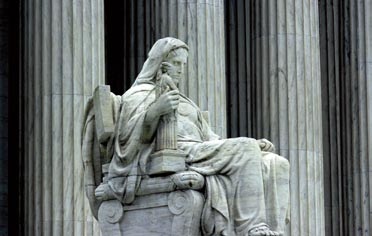
the Constitution?
judges – particularly nominees to sit on the Supreme
But critics of the “living document” approach argue
Court – a dispute that shows no sign of ending.
that this is an invitation to activist judges to write their
After his acquittal, Clarence Earl Gideon drifted
own notions of desirable social policy into the Constitu-
from one Florida tavern to the next until January 18,
tion. The critics often cite, as an example of this, the
1972, when he died at the age of 6l. That same year, the
Supreme Court’s decision in Roe v. Wade, the 1973 deci-
Supreme Court expanded its ruling in his case to require
sion that established a constitutional right for women
counsel for any defendant who, if convicted, might
to obtain abortions. The Court’s opinion held that
spend even one day in jail.
laws forbidding abortions violated the privacy rights of
Gideon was initially buried in an unmarked grave.
women and their physicians to make decisions involving
Donors later provided a headstone with this inscription:
abortions without interference from the state. The crit-
“Each era fi nds an improvement in law for the benefi t
ics point out that the Constitution and the Bill of Rights
of mankind.”
say nothing about privacy rights, and they allege that the
justices concocted an implied right of privacy in order to
arrive at a result they considered desirable.
Fred Graham has been a legal journalist since becoming Supreme Court cor-This constitutional debate has evolved into a heated
respondent for The New York Times in 1965. In 1972, he switched media, political struggle. Liberals, for the most part, favor the
becoming law correspondent for CBS Television News, and in 1989 was hired
“living Constitution” approach, while conservatives
by the then-new television legal network, Court TV, to be its chief anchor and argue that judges should leave lawmaking to the
managing editor. He is now Court TV’s senior editor, stationed in Washington, legislatures. One result has been an ongoing political
D.C. Mr. Graham has a law degree from Vanderbilt University and a Diploma dispute over the appointment and confi rmation of
in Law as a Fulbright Scholar at Oxford University.
75

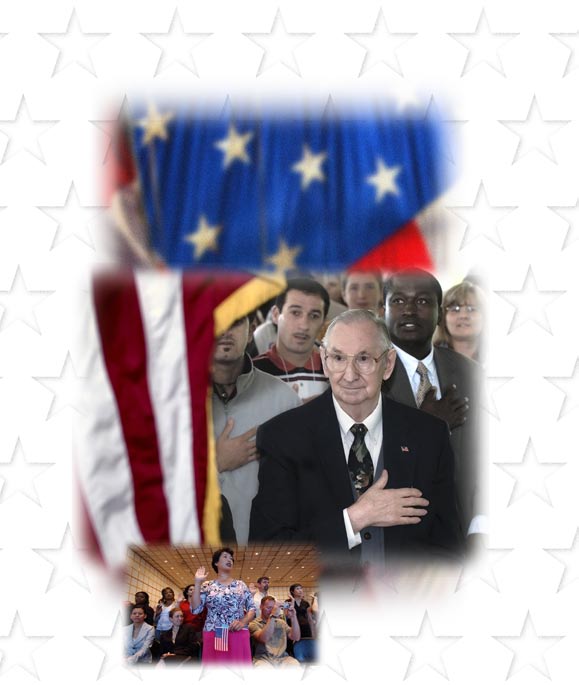
Immigration laws have affected the social, political, and economic
development of the United States, a nation of
immigrants since the 17th century – and earlier. Changes made to
law in the 1960s have resulted in a more diverse nation.
Below and left, new citizens take the oath of allegiance to the United States.
Facing page: President Lyndon B. Johnson at the signing ceremony for the Immigration Act of 1965.
76







by Roger Daniels
The Immigration Act of 1965:
Intended and Unintended Consequences
WHEN LYNDON JOHNSON SIGNED THE IMMIGRATION ACT
OF 1965 AT THE FOOT OF THE STATUE OF LIBERTY ON
OCTOBER 3 OF THAT YEAR, HE STRESSED THE LAW’S
SYMBOLIC IMPORTANCE OVER ALL:
THIS BILL THAT WE WILL SIGN TODAY IS NOT
A REVOLUTIONARY BILL. IT DOES NOT
AFFECT THE LIVES OF MILLIONS. IT WILL NOT
RESHAPE THE STRUCTURE OF OUR DAILY
LIVES, OR REALLY ADD IMPORTANTLY TO
EITHER OUR WEALTH OR OUR POWER. YET
IT IS STILL ONE OF THE MOST IMPORTANT
ACTS OF THIS CONGRESS AND OF THIS
ADMINISTRATION [AS IT] CORRECTS A CRUEL
AND ENDURING WRONG IN THE CONDUCT OF
THE AMERICAN NATION.
THE PRESIDENT FROM TEXAS WAS NOT BEING UNCHARAC-
TERISTICALLY MODEST. JOHNSON WAS SAYING WHAT HIS
ADVISORS AND “EXPERTS” HAD TOLD HIM. LITTLE NOTED
77

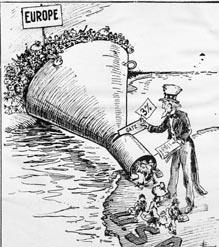
at the time and ignored by most historians for decades,
– continued to grow throughout the final two decades of
the 1965 law is now regarded as one of three 1965
the 19th century and the first two of the 20th.
statutes that denote the high-water mark of late 20th-
Perhaps because of the influx, anti-immigrant senti-
century American liberalism. (The other two are the
ment among nativists heightened when a sharp post-
Voting Rights Act, which enforced the right of African
World War I economic downturn combined with fears
Americans to vote, and the Medicare/Medicaid Act,
about the Bolshevik Revolution of 1917 and left-wing
which financed health care for older Americans and for
domestic radicalism resulted in a panic about a largely
persons in poverty.) The Immigration Act was chiefly
imaginary flood of European immigration. The chairman
responsible for the tremendous surge in immigration in
of the immigration committee of the House of Represen-
the last third of the 20th century (as Table I on page 80
tatives, Albert Johnson, a Republican representing a rural
shows) and also greatly heightened the growing
district in Washington state, used excerpts from consular
incidence of Latin Americans and Asians in the mix of
reports to argue that the country was in danger of being
arrivals to the United States in the decades that followed.
swamped by “abnormally twisted” and “unassimilable”
Why did the president’s experts so markedly misjudge
Jews, “filthy, un-American and often dangerous in their
the myriad potential consequences of the new law?
habits.” While those views were extreme for the time,
Because they focused on old
the consensus of Congress was
battles while failing to analyze
that too many Southern and
the actual changes which had al-
Eastern Europeans, predomi-
ready occurred by that date. In-
nantly Catholics and Jews, were
deed, to understand the nature
coming into the country – and
of the changes wrought and who
this view was clearly shared
was able to come to America as a
by many if not most Ameri-
result of the new law, it is neces-
cans in those days. Spurred by
sary to examine the prior course
such distaste, if not alarm, in
of American immigration policy.
the 1920-21 winter session of
Congress, the House of Repre-
American
sentatives voted 293-46 in favor
of a 14-month suspension of all
Immigration
immigration.
The somewhat less alarm-
Policy Before
ist Senate rejected the notion
of zero immigration and sub-
1921
stituted a bill sponsored by
Senator William P. Dillingham,
a Vermont Republican. His
plan was agreed to by Congress
Prior to 1882, there were no This 1921 political cartoon criticizes the U.S. government for trying to but was vetoed by the outgo-significant restrictions on
limit immigration (in those days mostly from Europe).
ing president, Woodrow Wilson.
any group of free immigrants who wanted to settle in the
The new Congress repassed it without record vote in the
United States of America. In that year, however, Con-
House and 78-1 in the Senate. Wilson’s successor, Presi-
gress passed the somewhat misnamed Chinese Exclusion
dent Warren G. Harding, signed it in May 1921.
Act (it barred only Chinese laborers) and began a 61-year
period of ever more restrictive immigration policies. By
1917, immigration had been limited in seven major ways.
First, most Asians were barred as a group. Among immi-
grants as a whole, certain criminals, people who failed to
meet certain moral standards, those with various diseases
and disabilities, paupers or “persons likely to become a
public charge,” some radicals, and illiterates were specifi-
cally barred. Yet, in spite of such restrictions, total immi-
gration – except during the difficult years of World War I
78

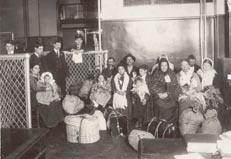
Immigration Quotas of the 1920s
If the consular officer believes that the applicant may
probably be a public charge at any time, even during a
considerable period subsequent to his arrival, he must
The 1921 act was a benchmark law placing the first
refuse the visa.
numerical limits, called quotas, on most immigra-
tion. A similar but more drastic version – the version
But even with the new restrictions, significant numbers
that Lyndon Johnson complained about – was enacted in
of immigrants continued to be admitted throughout the
1924. Then and later attention focused on the quotas,
1920s. In fact, the 1929 figure – almost 280,000 new im-
but they did not apply to all immigrants. Two kinds
migrants – would not be reached again until 1956. The
of immigrants could be admitted “without numerical
Great Depression and World War II reduced immigra-
limitation”: wives – but not husbands – and unmarried
tion drastically. As Table 2 on page 81 shows, both the
children under 18 of U.S. citizens, and immigrants from
number and incidence of foreign-born in the nation fell.
Western Hemisphere nations.
In each census from 1860 to 1920 the census recorded
Nations outside the Western Hemisphere were as-
that about one American in seven was foreign-born; by
signed quotas based origi-
1970 that figure had dropped
nally on the percentage of the
to fewer than one in 20.
population from that nation
Americans came to believe
among the foreign-born as
that the era of immigration was
recorded in the census of 1890,
over. The leading historian
which restrictionists called the
of American nativism, John
Anglo-Saxon census because
Higham, would write in his
it preceded the large influx of
1955 classic, Strangers in the
Southern and Eastern Europe-
Land, that:
ans. (After 1929 an allegedly
scientific method was used to
Although immigration of
reduce immigration even fur-
some sort would continue, the
ther.) Under both regimens,
vast folk movements that had
nations of Northwest Europe
formed one of the most funda-
got the lion’s share of new slots
Many poor immigrants, often from Eastern Europe,
mental social forces in Ameri-
entered the United States in the early 20th century through the ship terminal for immigrants, even though
can history had been brought
on Ellis Island, offshore New York City. Once a quarantine station,
already for decades most immi-
Ellis Island is now a museum.
to an end. The old belief in
grants had come from Eastern and Southern Europe.
America as a promised land for all who yearn for free-
The 1924 law also barred “aliens ineligible to citizen-
dom had lost its operative significance.
ship” – reflecting the fact that American law had, since
1870, permitted only “white persons” and those “of
Although no one seems to have perceived it, the era of
African descent” to become naturalized citizens. The
ever increasing immigration restriction had come to an
purpose of this specific clause was to keep out Japanese,
end a dozen years before.
as other Asians had been barred already. (American law
at the time defined Asians in terms of degrees of latitude
and longitude, a provision that left only those living west
Refugees and Other Wartime
of Afghanistan eligible for immigration to the United
States.) And, as a further control, all immigrants, quota
Changes
and non-quota, were required to obtain entry visas into
the United States from U.S. consuls in their country of
In December 1943, at the urging of President Franklin
origin before leaving. While some American foreign ser-
D. Roosevelt, who wished to make a gesture of sup-
vice officers were “immigrant friendly,” many, perhaps
port to a wartime ally, Congress repealed the 15 statutes
most, refused visas to persons who were legally eligible
excluding immigrants from China, gave a minimal im-
for admission. The State Department’s instructions to its
migration quota to Chinese, and, most important of all,
consular officials emphasized rejection rather than admis-
made Chinese aliens eligible for naturalization. Three
sion. A 1930 directive, for example, provided that:
years later Congress passed similar laws giving the same
rights to Filipinos and “natives of India,” and in 1952
79

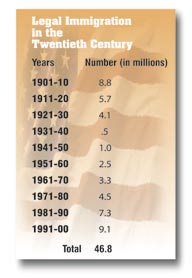
it erased all racial or ethnic bars to the acquisition of
find ways in which the United States could fulfill its “re-
American citizenship. Unlike immigration legislation of
sponsibilities to these homeless and suffering refugees of
the pre-World War II era, these and many subsequent
all faiths.” This is the first presidential suggestion that
changes in laws were motivated by foreign policy con-
the nation had a “responsibility” to accept refugees. It
cerns rather than concern about an anti-immigrant back-
has been echoed by each president since then.
lash among domestic constituents.
Truman himself sent no program to Congress. We
In addition, before 1952 other changes had taken place
now know, as many suspected then, that the White
as well in American policy. It had begun to make special
House worked closely with a citizens committee which
provision for refugees. In the run-up to World War II,
soon announced a goal of 400,000 refugee admissions.
Congress had refused to make such provision, most nota-
Success came in two increments. In June 1948, Congress
bly by blocking a vote on a bill admitting 20,000 German
passed a bill admitting 202,000 DPs, but with restrictions
children, almost all of whom would have been Jewish.
that many refugee advocates felt discriminated against
Former President Herbert Hoover backed it; President
Jews and Catholics. Truman signed it reluctantly, know-
Roosevelt privately indicated that he favored it but in the
ing that was the best he was going to get from Congress
end refused to risk his prestige by supporting it. Histori-
at that point. Two years later he signed a second bill
ans and policy makers would come,
which increased the total to 415,000
in the wake of the Holocaust, to
and dropped the provisions that he
condemn American failure to pro-
had complained about.
vide a significant haven for refugees
To create the illusion for their
from Hitler, though in point of fact
edgy constituents that the tra-
many Jewish refugees did make it
ditional quota system was still
on their own to American shores.
intact, Congress pretended that
Vice President Walter Mondale
the immigrants admitted by these
spoke for a consensus in 1979 when
bills above their national quotas
he judged that the United States
represented, in essence, “mort-
and other nations of asylum had at
gages” that would be “paid off” by
least in this sense “failed the test
reducing quotas for those nations in
of civilization” before and during
future years. This manifestly could
World War II by not being more
not be done. To cite an extreme
unreservedly generous to Hitler’s
example, the annual Latvian quota
potential victims.
of 286 was soon “mortgaged” until
Thus, the first of three bit-
the year 2274! Congress quietly
ter post-World War II legislative
cancelled all such “mortgages” in
battles over immigration policy
1957.
was fought between 1946 and 1950
In the event some 410,000 DPs
and focused on refugees. By the
were actually admitted. Only
end of 1946, some 90 percent of
about one in six were Jews; almost
the perhaps 10 million refugees in
as many, about one in seven, were
Europe had been resettled largely
Christian Germans expelled from
in their former homelands. The remainder, referred to as
Czechoslovakia and other Eastern European nations.
displaced persons, or DPs, were people who literally had
Most of the rest were Stalin’s victims, persons who
no place to go. Although DPs were often perceived as
had been displaced by the Soviet takeover of Eastern
a “Jewish problem,” only about a fifth of the 1.1 million
Europe, mainly Poles and persons from the Baltic
remaining DPs were Jews. Many of these wished to go
Republics.
to Palestine, then mandated to Britain, which refused to
allow them to enter.
President Harry S Truman tried for nearly two years
to solve the problem by executive action because Con-
gress and most Americans were opposed to any increase
in immigration in general, and to Jewish immigration in
particular. At the beginning of 1947 he asked Congress to
80


Continuing Controversy Over the numbers of Hungarian, Cuban, Tibetan, or Southeast Asian refugees and Congress would later regularize that
Quota System
action.
Analysis of all admissions during the 13 years that the
INA was in effect (1953-65) shows that some 3.5 million
While the immediate postwar refugee battle ended immigrants legally entered the U.S. Just over a third in favor of admitting at least some refugees, the
were quota immigrants. Non-quota immigrants were an
bitterness about immigration continued in an ongo-
absolute majority in every single year. Asian immigrants,
ing debate about revising the basic statutes largely
supposedly limited under an “Asia-Pacific triangle”
unchanged since 1924. The resulting statute, the 1952
clause to 2,000 per annum, actually numbered 236,000,
Immigration and Nationality Act (INA), also known as
almost 10 times the prescribed amount. Family mem-
the McCarran-Walter Act, was passed over Truman’s
bers of native-born or newly naturalized Asian Americans
veto while the Korean War raged. President Truman and
accounted for most of these. In addition, the INA years
most other liberals (but, interestingly, not Senator – later
mark the first period in American history in which Euro-
President – Lyndon
pean immigrants did
Johnson) were repelled
not dominate free im-
by a kind of side issue:
migration: 48 percent
the act’s Cold War
were from Canada, the
aspects which applied
Caribbean, and Latin
a strict ideological
America, with the
litmus test not only to
largest number from
immigrants but also
Mexico. Seven per-
to visitors. Under the
cent were from Asia,
provisions of the act,
and only 43 percent
many European intel-
from Europe.
lectuals, such as Jean
Paul Sartre, could not
The 1965
lecture at American
universities.
Immigration
Truman’s veto mes-
sage (overridden in
Act
the end by Congress),
praised the act’s aboli-
Although the
tion of all purely racial
national origins
and ethnic bars to
system was no longer
naturalization per se,
dominant, in the 1960s
its expansion of fam-
its last-ditch defense
ily reunification, and
was led in the Sen-
elimination of gender
ate by Sam J. Ervin,
discrimination. But the president said the INA “would
a North Carolina Democrat, who later, in the 1970s, was
continue, practically without change, the national origins
to become a hero to liberals for his role in the Watergate
quota system.” President Truman and most subsequent
hearings. But, in 1965, Ervin took a conservative stance,
commentators really failed to understand the full poten-
arguing that the existing quota system, as modified, was
tial impact of the limited changes wrought by the
not discriminatory but was rather “like a mirror reflecti




























